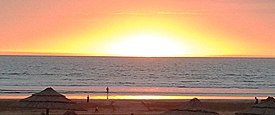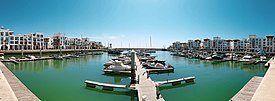Agadir
Agadir
| |
|---|---|
    Top:Panoramic view of Agadir, from Agadir Oufella, Second:Sunset view in Agadir Plage, Third:Corniche La Côte (Corniche Beach), Bottom:Agadir Marina | |
 Agadir Location in Morocco | |
| Coordinates: 30°26′N 9°36′W / 30.433°N 9.600°W | |
| Country | |
| Region | Souss-Massa |
| Prefecture | Agadir-Ida Ou Tanane |
| Area | |
| • Land | 51.2 km2 (19.8 sq mi) |
| Elevation | 74 m (243 ft) |
| Population (2014)[1] | |
| • Total | 487,954 |
| • Rank | 10th in Morocco |
| Time zone | UTC+1 (CET) |
| Website | Agadir (in Arabic and French) |
Agadir (Arabic: أكادير or Arabic: أݣادير or Arabic: أغادير, romanized: ʾagādīr; Tachelhit: ⴰⴳⴰⴷⵉⵔ, romanized: agadir) is a major city in Morocco, on the shore of the Atlantic Ocean near the foot of the Atlas Mountains, just north of the point where the Souss River flows into the ocean, and 509 kilometres (316 mi) south of Casablanca. Agadir is the capital of the Agadir Ida-U-Tanan Prefecture and of the Souss-Massa economic region. The majority of its inhabitants speak Berber, one of Morocco’s two official languages. It was the site of the 1911 Agadir Crisis that exposed tensions between France and Germany, foreshadowing World War I.
Introduction[]
Agadir is one of the major urban centres of Morocco. The municipality of Agadir recorded a population of 924,000 in the 2014 Moroccan census.[1] According to the 2004 census, there were 346,106 inhabitants in that year[2] and the population of the Prefecture of Agadir-Ida Outanane was 487,954 inhabitants.[2]
Three languages are spoken in the city: Tashelhit (first language of the majority), Moroccan Arabic, and French.
The city was destroyed by an earthquake in 1960; it has been completely rebuilt with mandatory seismic standards. It is now the largest seaside resort in Morocco, where foreign tourists and many residents are attracted by an unusually mild year-round climate. Since 2010 it has been well served by low-cost flights and a motorway from Tangier. The city attracts all walks of life; it has had an annual growth rate of over 6% per year in housing demand while housing production barely exceeds 3.4%.[citation needed]
The mild winter climate (January average midday temperature 20.5 °C/69 °F)[3] and good beaches have made it a major "winter sun" destination for northern Europeans.
Etymology[]
Very little remains of the Phoenician language, but numismatic inscriptions record that the Phoenicians knew the site as “a Gadir” or “Agadir” (Phoenician:

